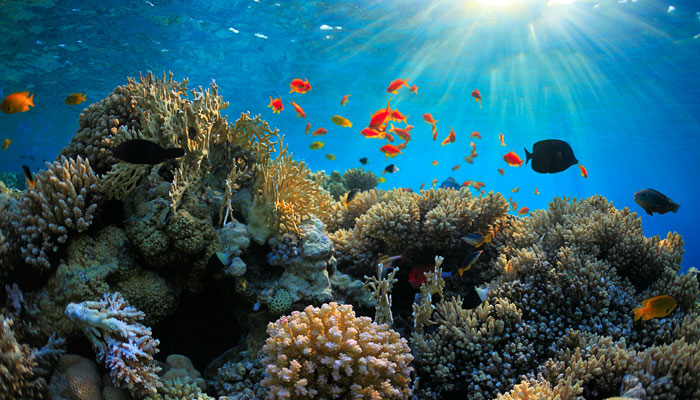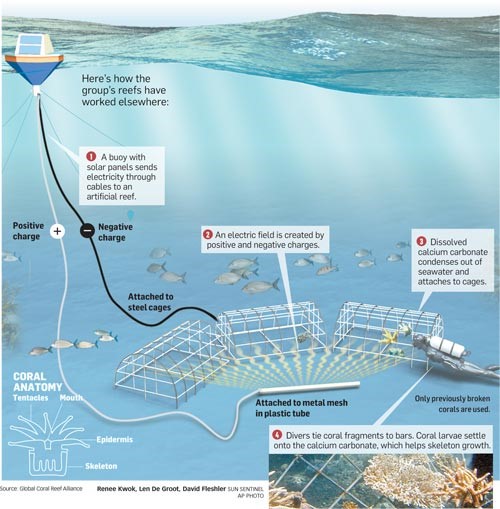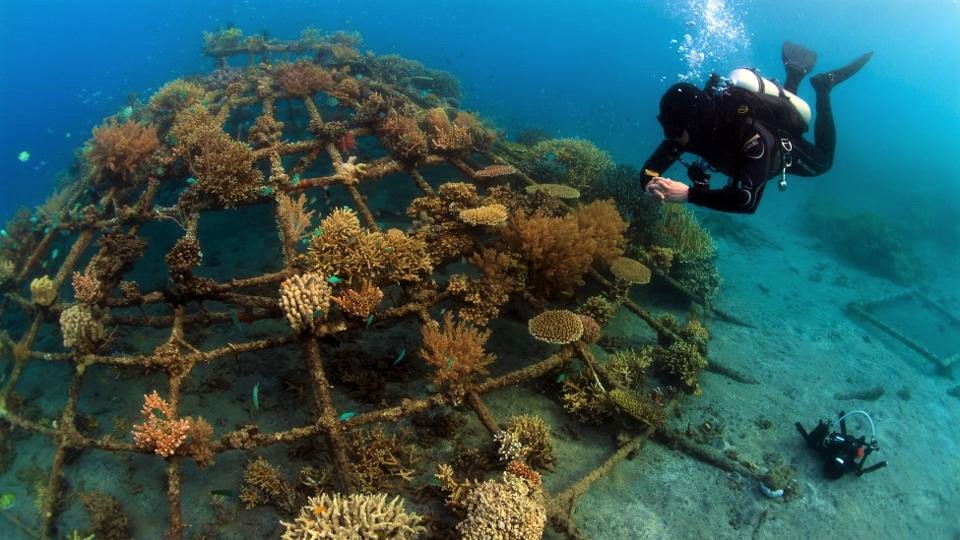How Scientists Are Using Solar Energy to Regenerate Extinct Coral Reefs in India
In India, marine scientists of Zoological Survey of India are using simple solar-powered structures to regenerate bleached or extinct coral reefs. Here's how this ingenious technology works.

Among the most biologically diverse and productive places on Earth, coral reefs cover just 0.2% of the world’s oceanic regions, yet they are home to 30% of all marine species. In addition to their incredible value as wildlife habitat, these reefs serve as a natural breakwater and protect coastlines from storms while providing food and jobs to thousands of people around the world.

Sadly, just like the rest of the environment, coral reefs are in trouble too. The reason? Coral bleaching or the death of zooxanthellae ( this symbiotic algae is the main source of nutrients for reef-building corals) due to rising seawater temperatures, overfishing, water pollution and other environmental factors tied to man-made climate change. Since it is the the presence of the algae that gives corals their brilliant colour, their death turns them white.
In the last two decades, three global mass bleaching events have taken place, with the most recent and devastating one beginning in 2014 and lasting for more than two years. According to the Global Coral Reef Monitoring Network (GCRMN), more than 25% of the world’s reefs are already gone and another quarter will die within the next twenty years!
With such events expected to increase in severity and frequency, scientists across the world have been trying to come up with various techniques that can regenerate bleached and locally extinct corals. In India, marine scientists are using solar energy to regenerate extinct corals through a technology known as Biorocks.

Originally developed by marine scientists Thomas Goreau and Wolf Hilbertz, Biorocks technology uses electricity to regrow corals. In this technique, a low-voltage direct current runs through a steel framework installed on the seabed and connected by cables to a power source such as solar panels, which would float on the surface of the sea.
The electricity passing through the submerged framework would trigger a chemical reaction in the sea water, similar to electrolysis, that would cause deposition of solid calcium carbonate (limestone) on the structure. This deposition of limestone, the same material that makes up marine skeletons, speeds up the normal process of coral regeneration..
Trained divers then move injured/semi-bleached corals into these biorocks to rehabilitate them. In these steel structures (that can be of any shape, from pyramids and planes to giant steel turtles, dolphins and manta rays), the corals have up to 50 times higher chances of survival.
They heal around 20 times faster, are densely branched and often have astonishingly vibrant colours! Once the corals are completely healed, they are returned back to the open sea while new ones take their place.

“It is just like giving oxygen to an athlete while he is running. With oxygen, he would be able to run faster and for a longer period. Similarly, it has been seen that providing small doses of electricity helps the corals to recuperate faster and survive longer,” says Chowdula Satyanarayana, a coral scientist with the Zoological Survey of India (ZSI), in an interview to the Hindustan Times.
Other than aiding the recovery of corals, biorocks are also the perfect breeding ground for aquatic life, particular shrimp, shellfish and juvenile fish populations who often take shelter in these structures.
By slowing the onslaught of turbulent waves, biorocks also prevents erosion of beaches. Instead they help in the deposition of sand on the shore line. During oceanic storms and natural disasters (like tsunami and typhoons), the structures are rarely damaged as their open framework allows large waves to pass through.
In India, solar-powered biorocks are being placed in the Gulf of Kutch off the coast of Gujarat. The pilot project is being carried out in the shallow waters of Shivrajpur beach near Dwarka in Gujarat to learn about how to address challenges like tidal fluctuations and siltation.

Other potential areas of deployments in India are the three other major coral reefs in the country – Andaman and Nicobar Islands, Lakshadweep, Gulf of Mannar and Gulf of Kutch. Interestingly, in 2014, an NIO expedition unearthed a submerged reef teeming with marine life at Angria Bank, a 600 sq km oceanic plateau situated 140 km off the Malvan coast of Maharashtra.
Other than taking lessons from Pemuteran in Indonesia (where biorocks are being used in the world’s largest coral regeneration project), the Zoological survey of India is collaborating with biorock developers and coral experts, Goreau and Hilbert, to improve and scale-up their coral regeneration project. The team is also exploring ways of harnessing wind energy and tidal energy to power biorocks.
With both global and national research providing insights into this promising technology, biorocks continue with their coral-conserving work in warm tropical waters of India. It is little wonder that these simple solar-powered structures have been named “coral arks” in the hope that they may prevent coral reefs from disappearing from the world forever.
Also Read: 20 Fascinating Facts About Andaman And Nicobar Islands We Bet You Didn’t Know
Like this story? Or have something to share? Write to us: [email protected], or connect with us on Facebook and Twitter.
NEW: Click here to get positive news on WhatsApp!

Similar Story

‘All For My Dad’s Memory’: This Hero Has Grown 12 Food Forests In The Heart of Mumbai
A tree lover since the age of 9, George Remedios quit his advertising job and founded ‘The Turning Tide’ to increase the forest cover in Mumbai. So far, he has planted 12 food forests with edible fruits and encourages people to grow their own food, even in limited spaces.
Read more >
If you found our stories insightful, informative, or even just enjoyable, we invite you to consider making a voluntary payment to support the work we do at The Better India. Your contribution helps us continue producing quality content that educates, inspires, and drives positive change.
Choose one of the payment options below for your contribution-
By paying for the stories you value, you directly contribute to sustaining our efforts focused on making a difference in the world. Together, let's ensure that impactful stories continue to be told and shared, enriching lives and communities alike.
Thank you for your support. Here are some frequently asked questions you might find helpful to know why you are contributing?


This story made me
-
97
-
121
-
89
-
167












